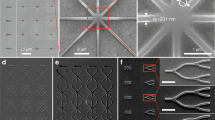Abstract
This paper reports the development of a three dimension maskless photolithography system with an oblique scanning method based on digital light processing technology. The system consists of a UV light source, a digital micromirror device (DMD), a microlens/pinhole array, two optical projection lenses, and a three-axis (xyz) servo-controlled stage. The optical system can form a rectangular array of UV spots with a diameter of few μm directly on the surface of a sample sitting on the stage. A photoresist (PR) layer is coated on the sample surface. Using an oblique scanning approach, the whole area of PR layer can be exposed by this UV exposure system in a maskless manner. Since the energy intensity of each UV spot can be independently modulated by a corresponding group of micromirrors in the DMD, and a three-dimensional (3D) UV dosage distribution can be achieved through computer programming on the DMD and the xyz stage. After developing processes, 3D PR microstructures with arbitrary patterns and/or surface profiles can be readily formed by this maskless lithography system. Experimental results will be addressed as well as potential applications for 2D and 3D microfabrication.









Similar content being viewed by others
References
Mack, C. (2007). Fundamental principles of optical lithography: The science of microfabrication. West Sussex: John Wiley & Sons Ltd.
Groves, T. R., Pickard, D., Rafferty, B., Crosland, N., Adam, D., & Schubert, G. (2002). Maskless electron beam lithography: prospects, progress, and challenges. Microelectronic Engineering,61–62, 285–293.
Kim, K. R., Yi, J., Cho, S. H., Kang, N. H., Cho, M. W., Shinn, B. S., et al. (2009). SLM-based maskless lithography for TFT-LCD. Applied Surface Science,255(18), 7835–7840.
Pease, R. F. (2005). Maskless lithography. Microelectronic Engineering,78–79, 381–392.
Diez, S. (2016). The next generation of maskless lithography. Proceeding of the SPIE,9761, 976102.
Liu, C., Guo, X., Gao, F., Luo, B., Duan, X., Du, J., et al. (2005). Imaging simulation of maskless lithography using a DMD. Proceeding of the SPIE,5645, 307–314.
Lee, D. H. (2010). Optical system with 4 μm resolution for maskless lithography using digital micromirror device. Journal of the Optical Society of Korea,14(3), 266–276.
Hansotte, E. J., Carignan, E. C., & Meisburger, W. D. (2011). High speed maskless lithography of printed circuit boards using digital micromirrors. Proceeding of the SPIE,7932, 793207.
Zhong, K., Gao, Y., Li, F., Luo, N., & Zhang, W. (2014). Fabrication of continuous relief micro-optic elements using real-time maskless lithography technique based on DMD. Optics & Laser Technology,56, 367–371.
Chan, K. F., Feng, Z., Yang, R., Ishikawa, A., & Mei, W. (2003). High resolution maskless lithography. Journal of Micro/Nanolithography, MEMS and MOEMS,2(4), 331–339.
Ryoo, H., Kang, D. W., & Hahn, J. W. (2011). Analysis of the line pattern width and exposure efficiency in maskless lithography using a digital micromirror device. Microelectronic Engineering,88(10), 3145–3149.
Chiu, C. C., & Lee, Y. C. (2012). Excimer laser micromachining of aspheric microlens arrays based on optimal contour mask design and laser dragging method. Optics Express,20(6), 5922–5935.
Hasan, Md N, Haque, M. U., & Lee, Y. C. (2016). Deastigmatism, circularization, and focusing of a laser diode beam using a single biconvex microlens. Optical Engineering,55(9), 095107.
Hasan, Md N, Dinh, D. H., Chien, H. L., & Lee, Y. C. (2017). Maskless beam pen lithography based on integrated microlens array and spatial-filter array. Optical Engineering,56(11), 115104.
Acknowledgements
This work is sponsored by the Ministry of Science and Technology of Taiwan under contracts of MOST 106-2221-E-006-135-MY2, MOST 106-3114-8-006-003, and MOST 107-2823-8-006-004.
Author information
Authors and Affiliations
Corresponding author
Additional information
Publisher's Note
Springer Nature remains neutral with regard to jurisdictional claims in published maps and institutional affiliations.
Rights and permissions
About this article
Cite this article
Chien, H.L., Lee, Y.C. Three Dimensional Maskless Ultraviolet Exposure System Based on Digital Light Processing. Int. J. Precis. Eng. Manuf. 21, 937–945 (2020). https://doi.org/10.1007/s12541-020-00318-8
Received:
Revised:
Accepted:
Published:
Issue Date:
DOI: https://doi.org/10.1007/s12541-020-00318-8




